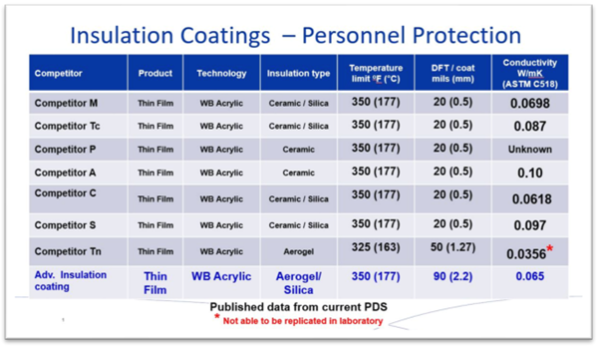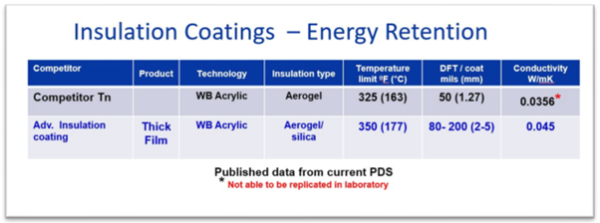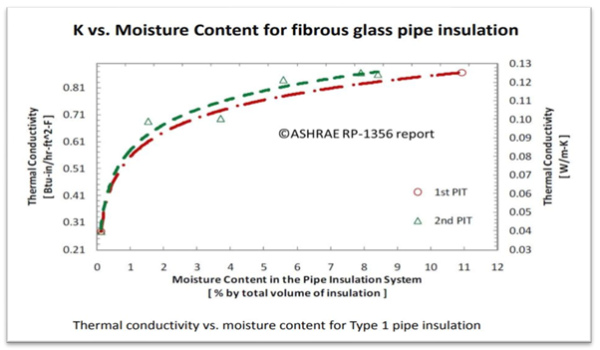Author: David Hunter.
This paper was presented at the Corrosion & Prevention 2023.
ABSTRACT
One definition of sustainability is “the avoidance of the depletion of natural resources in order to maintain an ecological balance”. Reducing energy consumption and therefore, by definition, the natural resources to produce the energy, is not only good environmental practice but also good business practice. Many processes require thermal insulation to maintain temperatures across a broad range of industries. This includes oil & gas, pulp & paper, chemical processing & refining, food production and disinfection for example. Insulation performance is greatly affected by moisture intrusion. Insulation and its performance are not a part of the curriculum of many engineering degree programs. Many engineers are often called upon to make value judgements about which insulation to select. The long term performance is often not well understood, and the loss of thermal performance can reduce the sustainability of a operation. This paper will discuss advances in conventional insulation alternatives (Insulation Coatings) which have performance and CUI mitigation properties which make them a cost effective & viable alternative for many industries.
Keywords: insulation, corrosion under insulation, insulation coatings, corrosion in Oil and Gas
INTRODUCTION
Maintaining temperature outside of ambient conditions for facilities or processes requires thermal energy. The most important thing to note is that heating or cooling of anything, requires energy resources (electric, steam, natural gas, oil, renewables) regardless of the source. In order to conserve energy, insulation materials were developed which resist the temperature change back to ambient conditions. Thermal insulation is the reduction of heat transfer (i.e., the transfer of thermal energy between objects of differing temperature) between objects in thermal contact or in range of radiative influence. There are many types and varieties of thermal insulation which have been developed. Insulation materials may be categorized into one of five major types: cellular, fibrous, flake, granular, and reflective[1], with brief descriptions below:
- Cellular insulations are composed of small individual cells either interconnecting or sealed from each other to form a cellular structure. Glass, plastics, and rubber may comprise the base material, and a variety of foaming agents are used.
- Cellular insulations are often further classified as either open cell (i.e., cells are interconnecting) or closed cell (cells are sealed from each other). Generally, materials that have greater than 90 percent closed cell content are considered to be closed cell materials.
- Fibrous insulations are composed of small diameter fibers that finely divide the air space. The fibers may be organic or inorganic and they are normally (but not always) held together by a binder. Typical inorganic fibers include glass, rock wool, slag wool, and alumina silica.
- Fibrous insulations are further classified as either wool or textile-based insulations. Textile-based insulations are composed of woven and non-woven fibers and yarns. The fibers and yarns may be organic or inorganic. These materials are sometimes supplied with coatings or as composites for specific properties, e.g., weather and chemical resistance or reflectivity.
- Flake insulations are composed of small particles or flakes that finely divide the air space. These flakes may or may not be bonded together. Vermiculite, or expanded mica, is flake insulation.
- Granular insulations are composed of small nodules that contain voids or hollow spaces. These materials are sometimes considered open cell materials since gases can be transferred between the individual spaces. Calcium silicate and molded perlite insulations are considered granular insulation.
- Reflective insulations and treatments are added to surfaces to lower the long-wave emittance, thereby reducing the radiant heat transfer to or from the surface. Some reflective insulation systems consist of multiple parallel thin sheets or foil spaced to minimize convective heat transfer. Low emittance jackets and facings are often used in combination with other insulation materials.
Performance of insulation primarily through control of three methods of heat transfer, namely conduction, convection and radiation. Conduction is the transmission of heat through a material, or from one material to another, through direct contact. Conduction can take place in solids, liquids and gases. Convection occurs in gases and liquids. If a hot surface is in contact with cooler air, heat is conducted to the air. This air then becomes warmer and therefore less dense than the adjacent cooler air. The warmer, lighter air rises upwards and is replaced by cooler air, causing a continuous flow of air by natural convection – gradually removing heat from the hot surface to the air. Radiation is the transmission of infra-red radiant energy from a ‘hot’ surface to a ‘cold’ surface through air or a vacuum. Radiant energy moves through space without heating anything in between – the energy is only absorbed when its path is blocked by an object which absorbs the energy and converts it to heat. All materials emit radiant energy to a greater or lesser extent according to their surface characteristics and the temperature of the surface. The higher the temperature of a surface the greater the amount of radiant energy emitted.
Another material sometimes referred to as “thermal insulating coatings” are available for use on pipes, ducts, and tanks. These coatings primarily work on a reflective principal which provides some thermal energy savings, but fairly low thermal resistance due to formulation, density, and limitations on thickness. Newer formulations of materials have improved the insulation properties of thermal insulation coatings which can offer users significant advantages over other types of insulation materials.
RESEARCH SIGNIFICANCE
Thermal insulation coatings have been used successfully in industry in excess of 25 years. Their broader uses have been limited due to the fact that the materials, although technically feasible, cannot cost effectively be applied at high dry film thicknesses approaching that of conventional insulation. In general, increased insulation thickness will proportionally increase the thermal resistance or R-value — the higher the R-value, the greater the insulating effectiveness. New formulations provide the opportunity to increase the scope of applications, with the associated features and benefits.
METHODS AND MATERIALS
A thorough literature review of the thermal insulation coating products was studied to understand features, benefits, and factors that affect insulation coatings performance.
EVALUATION OF DIFFERING INSUALTION COATING MATERIALS
An insulating material’s resistance to conductive heat flow is measured or rated in terms of its thermal resistance or R-value — the higher the R-value, the greater the insulating effectiveness. The R-value depends on the type of insulation, its thickness, and its density. The R-value of most insulations also depends on temperature, aging, and moisture content / absorption.
Mathematically, R is:

where:
- L is the insulation thickness in inches,
- k is thermal conductivity, (BTU)(in)/(ft2)(oF)(hr), often thought of as a constant for given materials
Most conventional insulators methods use a standardized American Standards and Testing Methods (ASTM) testing method to gauge the insulation’s effectiveness. This is often expressed as “k” value, or thermal conductivity. There are many types of thermal conductivity tests however the two most significant tests in describing insulation are:
- ASTM-C-177 Test Method C177-97 for Steady-State Heat Flux Measurements and Thermal Transmission Properties by Means of the Guarded-Hot-Plate Apparatus
- ASTM-C-518 Test Method C518-98 for Steady-State Thermal Transmission Properties by Means of the Heat Flow Meter Apparatus
ASTM C-177 tests are designed to measure insulation samples in the 1-2-inch range. Many insulation coatings, however, are challenged to even obtain a 1.0” (≈ 25.4 mm) thickness in a cost-effective manner. For instance, for most insulation coatings, this would equate to 50 coats applied at twenty-mils (0.50 mm) each. Insulation coatings are effective in mitigating the effects of radiant heat and as personnel protection barriers, but insulation coatings
broader use has been limited by their ability of the materials to be applied at higher film thicknesses. As a result, many insulation coating manufacturers have used a concept called R VALUE EQUVILANCY (RvE) This method attempts to compare conventional insulation systems to insulating coatings in a head-to-head comparison. RvE is defined as taking the value for the coating and divided by the thickness of the coating, the outcome is a R value which appears to compare favorably to other insulation materials. The values stated do not hold up to empirical field data.
Advances in insulation coating formulations using aerogels have recently entered the market. Aerogels are a class of synthetic porous ultralight material derived from a gel, in which the liquid component for the gel has been replaced with a gas, without significant collapse of the gel structure.[2] The result is a solid with extremely low density and extremely low thermal conductivity. According to Wikipedia “Aerogels are good thermal insulators because they almost nullify two of the three methods of heat transfer – conduction (they are mostly composed of insulating gas) and convection (the microstructure prevents net gas movement). (Silica aerogel is an especially good insulator because silica is also a poor conductor of heat; a metallic or carbon aerogel, on the other hand, would be less effective.) They are good convective inhibitors because air cannot circulate through the lattice.” In addition, the material can be formulated to produce high dry film thicknesses which allow the insulation coating to perform more comparably to conventional insulation.
RESULTS
By creating formulas with low thermal conductivity materials which can be applied at significant film thickness comparable to some conventional insulations, insulations coatings now can have comparable thermal performance as shown in Figures 1 and 2.

FIGURE 1: VIEW OF COMPARABLE INSULATION COATINGS ON THE MARKET FOR PERSONNEL PROTECTION. NOTE FILM THICKNESS PER COAT AND COMPARABLE THERMAL CONDUCTIVITIES

FIGURE 2: VIEW OF COMPARABLE INSULATION COATINGS ON THE MARKET FOR ENERGY RETENTION. NOTE FILM THICKNESS PER COAT AND COMPARABLE THERMAL CONDUCTIVITIES
One large advantage of insulation coatings is that they can be spray applied, reducing the coating installed costs of the solution vs. conventional insulations. The multi-coat application goes on with no seams between the insulation sections, reducing or eliminating the probability of Corrosion Under Insulation, (CUI), a major industry concern. One drawback to conventional insulation is the weather jacketing. Regardless of type, since the jacketing and the insulation are not bonded to the steel, any corrosion under the insulation will be masked from visual inspection until often there is significant section loss in the piping or vessel. Insulation coatings by contrast are bonded directly to the substrate, therefore any corrosion under the coating will be visually identifiable, reducing inspection cost and allowing the owner to catch the problem before there is loss of section or worse, a leak.
A second factor that is an advantage to insulation coatings is its ability to maintain its thermal efficiency for the life of the coating. Conventional insulation systems face efficiency losses over their lifetime due to inevitable water intrusion. The American Society of Heating, Refrigeration and Airconditioning Engineers performed a study called the ASHRAE Research project Report RP-1356, January 2012[3], which looked at the effect of moisture on insulation performance over several types of conventional insulation. From the study, as an example, for fibrous glass pipe insulation, with as little as 3% moisture in the insulation, the ability to insulate decrease by a factor of 2.7. See Figure 3.

FIGURE 3: VIEW OF THE MOISTURE ON THERMAL CONDUCTIVITY. NOTE: THE LOWER THE K VALUE, THE BETTER THE INSULATION IS PERFORMING
CONCLUSIONS
Insulation coatings have now been developed to solve a myriad of problems such as personnel protection, energy retention, anti-condensation / freeze protection, process stability, reduction of evaporative losses (fuels), reduction of radiant heat gain. With the exception of personnel protection, all the aforementioned require energy resources which often increase carbon footprint. By conserving energy, and facilities can both reduce carbon footprint and reduce operating costs, which is a win for both environmental concerns as well as shareholder / stockholders. Advances in insulation coatings offer some alternative solutions to traditional insulation, while significantly improving process safety by minimize the cost of identifying and managing corrosion under insulation.
ACKNOWLEDGMENTS
The source of any information borrowed from a paper/book should be indicated in this section. The names of authors in your references should be formatted as the last names of the authors followed by the first initials. Please note that references should not have active hyperlinks.
References
- Types of Insulation. 2022, August 25, Insulation Outlook Magazine, https://insulation.org/io/articles/types[1]of-insulation/
- Definitions of terms relating to the structure and processing of sols, gels, networks, and inorganic-organic hybrid materials (IUPAC Recommendations 2007). Pure and Applied Chemistry. Vol. 79. 2007. pp. 1801–1829. doi:10.1351/goldbook.A00173. ISBN 978-0-9678550-9-7. Archived from the original on 30 November 2012.
- Cremaschi L., Ghajar A., Worthington, K, (2012) RP-1356 – “Methodology To Measure Thermal Performance Of Pipe Insulation At Below-Ambient Temperatures”, ASHRAE Report
AUTHOR DETAILS
| David Hunter is a Civil Engineer and Segment Development Manager for Corrosion Under Insulation (CUI), High Heat & Insulation Coatings for Hempel, which he has held since 2021. He has 28 years of coatings and corrosion experience includes consulting in CUI, protective coatings, linings, composites, and passive fire protection materials. Hunter is 16 year AMPP instructor for the Coatings Inspector Program, Fireproofing Inspector, Corrosion Under Insulation as well as 8 other courses. |